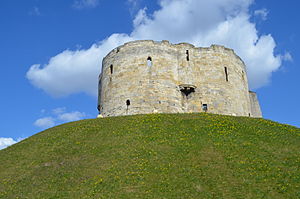York Castle
| York Castle | |
|---|---|
| Yorkshire, England | |

Clifford's Tower, the keep of York Castle
|
|
|
Shown within North Yorkshire
|
|
| Coordinates | 53°57′21″N 1°04′48″W / 53.9558°N 1.0800°WCoordinates: 53°57′21″N 1°04′48″W / 53.9558°N 1.0800°W |
| Grid reference | grid reference SE603514 |
| Type | Shell keep and bailey |
| Site information | |
| Owner | English Heritage, York Museums Trust, Her Majesty's Courts Service |
| Condition | Ruined keep, restored part curtain-wall, surviving 18th century buildings used as a museum and York's Crown Court |
| Site history | |
| Materials | Magnesian limestone |
| Battles/wars | Siege of York in 1644 |
| Events | Jewish massacre of 1190 |
|
Listed Building – Grade I
|
|
| Designated | 14 June 1954 |
| Reference no. | 1259325 1259360 1259324 1259328 1259329 |
York Castle in the city of York, England, is a fortified complex comprising, over the last nine centuries, a sequence of castles, prisons, law courts and other buildings on the south side of the River Foss. The now-ruinous keep of the medieval Norman castle is commonly referred to as Clifford's Tower. Built originally on the orders of William I to dominate the former Viking city of York, the castle suffered a tumultuous early history before developing into a major fortification with extensive water defences. After a major explosion in 1684 rendered the remaining military defences uninhabitable, York Castle continued to be used as a jail and prison until 1929.
The first motte and bailey castle on the site was built in 1068 following the Norman conquest of York. After the destruction of the castle by rebels and a Viking army in 1069, York Castle was rebuilt and reinforced with extensive water defences, including a moat and an artificial lake. York Castle formed an important royal fortification in the north of England.
In 1190, 150 local Jews were killed in a pogrom in the castle keep, most of them committed suicide in order not to fall to the hands of the mob. Henry III rebuilt the castle in stone in the middle of the 13th century, creating a keep with a unique quatrefoil design, supported by an outer bailey wall and a substantial gatehouse. During the Scottish wars between 1298 and 1338, York Castle was frequently used as the centre of royal administration across England, as well as an important military base of operations.
York Castle fell into disrepair by the 15th and 16th centuries, becoming used increasingly as a jail for both local felons and political prisoners. By the time of Elizabeth I the castle was estimated to have lost all of its military value but was maintained as a centre of royal authority in York. The outbreak of the English Civil War in 1642 saw York Castle being repaired and refortified, playing a part in the Royalist defence of York in 1644 against Parliamentary forces. York Castle continued to be garrisoned until 1684, when an explosion destroyed the interior of Clifford's Tower. The castle bailey was redeveloped in a neoclassical style in the 18th century as a centre for county administration in Yorkshire, and was used as a jail and debtors' prison. Prison reform in the 19th century led to the creation of a new prison built in a Tudor Gothic style on the castle site in 1825; used first as a county and then as a military prison, this facility was demolished in 1935. By the 20th century the ruin of Clifford's Tower had become a well-known tourist destination and national monument; today the site is owned by English Heritage and open to the public. The other remaining buildings serve as the York Castle Museum and the Crown Court.
...
Wikipedia

